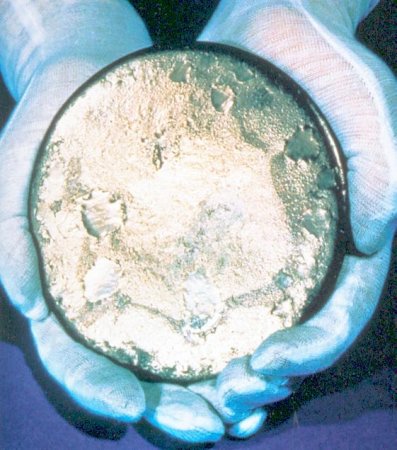

Above: a 1960s (generation one) pressurised water reactor plant
A nuclear power station is essentially a steam turbine. Indeed, they are often considered in the same breath as coal, shale gas, and oil fueled power stations due to the fuel being used to heat (or, sometimes, boil) water. This article will only focus on water-cooled thermal reactors for brevity, because other than a handful of test reactors, they are the ones that exist right now.

Uranium is a heavy element. In fact, for a long time, it was thought of as the heaviest naturally occurring element. Later discoveries showed that neptunium and plutonium also occur naturally, but that's not so important right now. Uranium is very heavy, and as such is nearly tearing itself apart because heavier atoms can have less neutrons—which act a bit like glue—than protons (and more radioactive, although this is true of any atom with too many neutrons, including hydrogen-3), there are two types of uranium that only need a small push (in artificial reactors, a neutron) to break apart and release energy. These are uranium-233 and uranium-235, both of which have been used, but uranium-235 is preferred for solid-fueled reactors.
The amount of fuel required to sustain a chain reaction is called the critical mass, where criticality refers to one reaction leading to one other reaction.
Although water boils at 212 degrees Fahrenheit (100 degrees centigrade), typical reactor operation temperature exceeds 500 degrees F. Because of this, water is pressurised to 150 times the sea-level atmosphere. This prevents the water from boiling into steam, since steam takes up 1,000 times the volume of liquid water. Because zirconium, which is ussed in cladding to protect the reactor from wear, forms zirconium hydride (ZrH2) very, very easily, and liquid water is easy to separate by using a simple neutron, a recombiner system is employed to keep ZrH2 from forming and subsequently decomposing back into zirconium and hydrogen. Hydrogen gas can be pressurised easily, and in a PWR can build up, leading to a loss-of-coolant accident (often incorrectly called a "meltdown"; while fuel melt generally occurs because of a loss of coolant, molten fuel isn't the explosive force, pressurised hydrogen gas is) like those that happened at Three Mile Island-2 and Chernobyl-4.
The uranium fissioning heats the water past normal boiling temperature. This water is run past a second loop of water, which boils into steam to drive a turbine. This steam gets sent through a condenser, before looping back into the heat transfer. This system generates one gigawatt of electricity.

Due to the high cost of PWR pressure vessels, and to save on steel and costs, a boiling water reactor design may be iused instead of more typical pressurised water forms. Instead of a primary and secondary water loop corresponding to heat and steam rurbine, as on a PWR, the water is allowed to boil from the fission, going through the steam loop directly from fission coolant as opposed to simply heating the steam loop.
Otherwise, PWRs and BWRs are essentially the same machine.
See this table for more info:
| PWR | BWR | |
|---|---|---|
| Water | Heated in core, kept liquid by pressure, ran against other water. |
Boiled in core, not kept liquid, core water turns the turbine. |
| Pressure | 155 bar | 70 bar |
| Parts | Several points of failure. |
Far fewer points of failure. |
| Safety | Somewhat less so than BWR, but still not horrible. |
Somewhat more so than PWR. |
| Cost | Usually around $10 billion |
Usually around $8 billion |

There exists a third design, which is broadly similar, but when looked at closely shows much difference. The CANDU (Canada, hydrogen-2, uranium) reactor, instead of using hydrogen with no neutron, uses hydrogen with one. This was a rare form of water in the 1950s and '60s, but nowadays is more common, with this as its primary use. Because the hydrogen in the water already has a neutron, it keeps bonded even when neutrons collide with it. As such, it can use unenriched uranium fuel because the hydrogen isn't capturing enough neutrons to raise the critical mass.
Because of this, CANDU reactors remove the need for enriched fuel, meaning that from a proliferation standpoint CANDUs are that much safer. However, proliferation is mostly a non-issue in commercial power stations anyway.
Not all military uses are for atomic weapons.
In fact, both the Navy and Army use reactors for power uses, on bases both domestically, abroad, and at sea. The biggest use of nuclear power nowadays in the U.S. Military is in naval reactors (which use 50% enriched uranium, unique in reactors), which are very numerous. Nuclear submarines mostly replaced gas submarines in the 1970s, and while nowadays there's a mixture of both, nuclear submarines with conventional missiles are here to stay.
As hinted at before, naval reactors are all PWR types, which is alright; at such small scales (the submarine intermediate reactor was sixty megawatts of power) the PWR is failsafe. The potential issues only come to light in larger designs - 300 MWe and above.
Ultimately, even the military nuclear reactors are fairly safe from proliferation.